I have updated my coral database and have posted pictures below. For my customers, please bookmark this page for reference. I have painstakingly built a database on an Excel format. If you are a dealer, and would like the database with prices, please email me at joylucktp2000@yahoo.com. If you are a hobbyist, I can also send you the database, but without the prices.
Coral database 2010
Donut coral. Also known as "meat corals". The fish and wildlife in the US now officially recognizes this coral as Acanthophyllia desheysiana. It has been mis identified as Scolymia australis for a long time. It is getting harder and harder to find these gorgeous corals, or at least nice red ones. Brown and common greens are dime a dozen. This is one of the corals that is grossly underpriced at the export level. In a few years, I believe this coral will become a collector's item, as nice specimens are only found in certain few parts of Indonesia. There is a myth that Australia has these incredible corals, but Australian reefs harbors only brown green ones.
Comes in multiple colors, most popular are the "multicolor" ones. Sometimes a true weird color morph will show up, like purple, pink, sometimes even shades of blue! The solid red ones tend to more high priced locally and harder to find.




















Micromussa amakuensis. One of my recent finds, have been looking for this coral for a long time in Indo. You could imagine the excitement on my part when I first discovered this coral. Actually this coral has been floating around in Indo, but only few. Due to lack of knowledge, it just got passed as a favia or favites. The first specimens were just metallic red or orange with bright white or green centers. Later on, I started seeing "acan" stripes on some of the specimens, started to look like the traditional micromussas as we know. Outstanding coral that is relatively rare. Hard to imagine a coral more mettalic red/orange than these beauties!









 Blastomussa wellsi Ultra. "Little gems in the reefs", as I like to call them. These are not the regular red and green two colored pieces. These are my ultra grade selections. The sizes usually are small, but the colors are insanely beautiful!
Blastomussa wellsi Ultra. "Little gems in the reefs", as I like to call them. These are not the regular red and green two colored pieces. These are my ultra grade selections. The sizes usually are small, but the colors are insanely beautiful!










 This rare blasto seems to be a hybrid between a wellsi and a merletti. It is only found in very deepwater and has wellsi heads with merletti body. The problem is that only few heads normally survive the collection. Very rare and for collector's only!
This rare blasto seems to be a hybrid between a wellsi and a merletti. It is only found in very deepwater and has wellsi heads with merletti body. The problem is that only few heads normally survive the collection. Very rare and for collector's only!




Blastomusssa wellsi first pick. These blastos are the nomal red and greens. Still, very nice and bright!









 Cynarina lacrymalis. Gorgeous translucent reds make this coral one of the prettier corals in the reef. Also comes in green, but not so popular for obvious reasons.
Cynarina lacrymalis. Gorgeous translucent reds make this coral one of the prettier corals in the reef. Also comes in green, but not so popular for obvious reasons.




Bali brain Ultra. Also known as "wellsophyllia". The fish and wildlife recognizes this corals as a trachyphyllia geoffroyi. The regular morphs are red and green. These are my ultra picks, very rare and highly prized!







Bali brain red. Relatively rare in the trade. Many years ago, they were plenty but now getting harder to find. Common green or ugly reds are common, but nice ones like below are hard to come by these days. Also in this category are the multicolors, I like to call them. Some are incredible!
















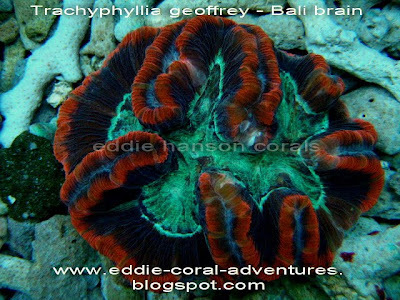

 Echinophyllia chalice. Probably the most desired coral species in the US. Took me a long time to get the suppliers and fisherment to look for this coral. Now they recognize these corals right away and know that "mr. eddie" (that is what I am called) wants them! Once in a while, I will find a watermelon type, but very rare!
Echinophyllia chalice. Probably the most desired coral species in the US. Took me a long time to get the suppliers and fisherment to look for this coral. Now they recognize these corals right away and know that "mr. eddie" (that is what I am called) wants them! Once in a while, I will find a watermelon type, but very rare!

























 I can picture this coral turning into a watermelon type in the future. It already has green eyes and rim. The body color is pink/red!
I can picture this coral turning into a watermelon type in the future. It already has green eyes and rim. The body color is pink/red! Wow! pink eyes - way cool!
Wow! pink eyes - way cool!
 One of the watermelon types that has colored up in a tank.
One of the watermelon types that has colored up in a tank.Trachyphyllia brain Ultra. These are "Japanese" colors, as I like to call them. Morphs similar to these appear in Japanese reef magazines all the time. Rare and color patterns are most intriguing!




 Trachyphyllia multicolor. These are almost like my Japanese ultra picks, but not quite that fancy. Still, the colors are really nice!
Trachyphyllia multicolor. These are almost like my Japanese ultra picks, but not quite that fancy. Still, the colors are really nice! Love you!
Love you!
















Trachyphyllia brain red. These are my first pick red and green trachys. I only pick out the best ones for export. There are plenty of the washed up bleached ones in the trade.









 Yuma multicolor. These beautiful Ricordia yumas comes in combinations of red, green, blue, purple, orange, pink. Immensely popular but like many other corals, not as abundant as before.
Yuma multicolor. These beautiful Ricordia yumas comes in combinations of red, green, blue, purple, orange, pink. Immensely popular but like many other corals, not as abundant as before.















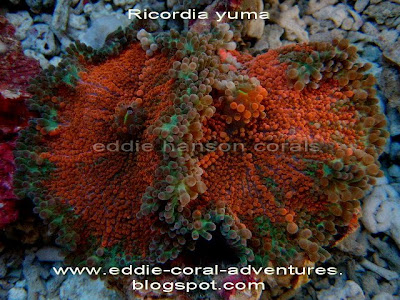








Yuma red. Colors are normally bright pink to metallic red, sometimes with streaks of blue or green mouths! Relatively rare and sensitive. Captive survivability is poor on these particular corals, definitely not for newbies!









 Acanthastrea maxima. Locally known as "eddie lobo" or "blasto eddie". I discovered these unique small gems a few years back. Before these were mistaken for single headed blastos and no one wanted them. Now they are popular than ever. Mostly abundant in single heads, although I am increasingly finding two and three headed specimens. What makes this coral interesting is that I keep finding more new color morphs. The new ones I have now are insanely looking!
Acanthastrea maxima. Locally known as "eddie lobo" or "blasto eddie". I discovered these unique small gems a few years back. Before these were mistaken for single headed blastos and no one wanted them. Now they are popular than ever. Mostly abundant in single heads, although I am increasingly finding two and three headed specimens. What makes this coral interesting is that I keep finding more new color morphs. The new ones I have now are insanely looking!
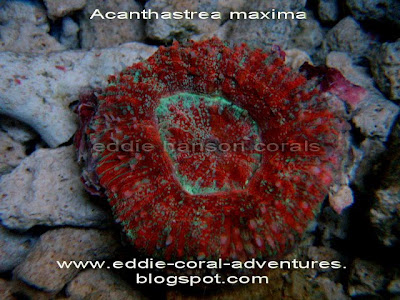






























 Acanthastrea bowerbanki. Rare and extraordinary acan species! Very rare and always distinct. It has a large central head surrounded by smaller ones, sometimes it will have two large heads and smaller ones surrounding each. I've seen specimens where the rim turns green under artificial lighting - nice!
Acanthastrea bowerbanki. Rare and extraordinary acan species! Very rare and always distinct. It has a large central head surrounded by smaller ones, sometimes it will have two large heads and smaller ones surrounding each. I've seen specimens where the rim turns green under artificial lighting - nice!



 Unidentified acan lobo. These strange corals are beautiful and unusual. You can tell right away that they are an acan species, but it also resembles a lobo. It is for sure an acan species, perhaps a new one that is not in the books. Acan colors with lobo features - very rare!
Unidentified acan lobo. These strange corals are beautiful and unusual. You can tell right away that they are an acan species, but it also resembles a lobo. It is for sure an acan species, perhaps a new one that is not in the books. Acan colors with lobo features - very rare!
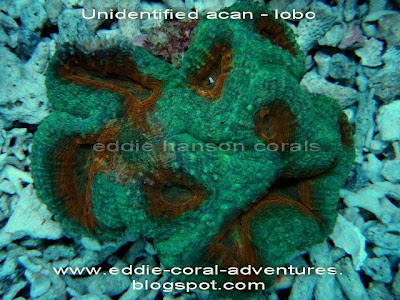


 Unidentifed lobo acan. So these corals are similar to the ones above, but seems to have opposite features. These look like lobos right away, but has acan colors. Most of them are mistaken for lobos. Very rare and unusual!
Unidentifed lobo acan. So these corals are similar to the ones above, but seems to have opposite features. These look like lobos right away, but has acan colors. Most of them are mistaken for lobos. Very rare and unusual!



 Echinomorpha. Strange coral that is also mistaken as a lobophyllia. Extremely rare and only few specimens are floating around Indonesia.
Echinomorpha. Strange coral that is also mistaken as a lobophyllia. Extremely rare and only few specimens are floating around Indonesia.



 Acanthastrea lordhowensis. Such a rare coral it used to be. I remember back in the days when each head of these could sell for $100! Colors come in red mixed in with green, or sometimes orange and yellow - nice!
Acanthastrea lordhowensis. Such a rare coral it used to be. I remember back in the days when each head of these could sell for $100! Colors come in red mixed in with green, or sometimes orange and yellow - nice!




Acanthastrea echinata. Beautiful acan species that are popular. Much more popular than the lord species. Why? Due to Australian lords dominating the market, Indo ones can't compete. But Australia do not have these intense looking echinatas!





echinata - lg head. Definitely an echinata species but strange that it has extra large heads. Always found as small pieces and pretty rare!




 Acanthastrea rotundoflora. I call these "rotundos" for short. Another coral that I have made famous in Sulawesi. Resembles a chalice and forms a beautiful green rim under good lights!
Acanthastrea rotundoflora. I call these "rotundos" for short. Another coral that I have made famous in Sulawesi. Resembles a chalice and forms a beautiful green rim under good lights!




Symphyllia. Recently my suppliers (due to me constantly asking to find these corals), have been getting from their fishermen in good numbers. Now it is becoming a popular coral. We will see more of these beauties in the trade as time goes by. The demand has picked up quite high from the exporters. I have some now that are jaw dropping beautiful! The problem is that these beauties tend to loose color quickly, so shipping them out soon after aquiring them is the trick.










Lobophyllia. Comes in corymbose shape and deeper water branching. The colors are red, green, purple, pink. The branching ones are typically green and orange.









 Fungia red. Extremely rare, comes in metallic red/fuscia, sometimes with yellow or green polyps - collector's item!
Fungia red. Extremely rare, comes in metallic red/fuscia, sometimes with yellow or green polyps - collector's item!




Fungia - half red. These are red fungias that have lost color or needs to color up. Normally it would only take a few months to color up to potential. Also included in this group are any fungias with red, like the green one with the red polyps below. These half reds are rare, although not quite rare like the metallic versions!










Fungia first pick. These are my first pick fungias. Colors are orange, orange with green polyps, orange-yellow to green, sometimes with purple polyps, etc..
















Scolymia vitiensis. True Indonesian Scolymia vitiensis. These cool corals were mistaken for lobos when I first got to Makassar. I soon started using the term "true Indo scolymia vitiensis" to differentiate them from the mistaken identity of the donut coral (Acanthophyllia desheysiana). The term has stuck, sometimes I see this coral for sale on the internet as "true Indo scolymia vitiensis". Colors come in red, orange - green, and metallic green, sometimes with strange circular patterns. This coral can be confused with anther cool coral called an Australomussa, which looks similar. I don't include in my database because I have only found it a few times.










Leptastrea. This sacred coral is really rare. I have only found about 6 specimens in the three years that I ahve been here. Colors range from orange to orange - green. Every specimen I have ever found were super metallic. Most of the time, this coral is passed on as a goniopora, a highly "undesired goniopora". I'm positive that many of these precious corals end up at the exporter's facility as leftovers and never get sent. If you didn't know it, it always looks brown to the common eye, but my eyes are special:)



Cyphastrea. Extremely rare to find a metallic orange one. Usual colors are green and brown. Only a handful of specimens ever found in the orange, in the three years of exporting corals from Indo!

Favia. Colors available in red and green. Sometimes a strange colored one like purple or pink will show up. Specimens with yellow centers in the red eyes are especially nice!















Zoanthid Makassar. These are special metallic red zoanthids from Makassar. Colors and patterns vary a little in every piece. The most famous is called "Sopranos", which my customer have named. I sometimes refer to these as Makassar speckled zoanthids. Very rare, lucky to find a piece in a week.















Zoanthid blue. These are blue zoanthids and palythoas. Colors range from sky blue to dark blue. As you can guess, they are relatively hard to find. Used to be much more plentiful, but now they are getting to be pretty rare.




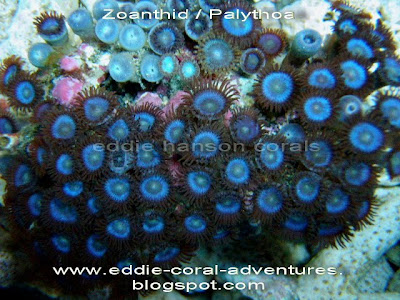










Zoanthid/Palythoa first pick. These are my first pick general zoanthids and palythoas. I go through hundreds to pick out the best few pieces. For the most part, most of them are plain green and common.






















Aquaculture. I go island hopping and search out the best pieces for color and species. From the 1000 islands in West Java, to shallow water in Bali, to deepwater Northern Bali, I provide the variety that no one can match!

















Me in Serangan island in Bali with baskets of aquacultures that I just had hand picked from the racks!


 Montipora wild. Finding good montiporas is not easy. I do however have special suppliers (and fishermen) that I have trained on what species is good! Normal species includes undatas, confuscias, peltiformis, informis, monasteriatas, tuberculosas (superman - superman is not a danea species!). I avoid the common swirling capricornis types (most abundant).
Montipora wild. Finding good montiporas is not easy. I do however have special suppliers (and fishermen) that I have trained on what species is good! Normal species includes undatas, confuscias, peltiformis, informis, monasteriatas, tuberculosas (superman - superman is not a danea species!). I avoid the common swirling capricornis types (most abundant).














Acropora wild. I am probably most known for acroporas. Acros are my specialty, so if you have special species requests, I can tell you if I can get or haven't seen. I love the deepwater species especially. Lokanis (Steve Tyree's and Eddie's (me)purple monster species, elegans, granulosas, carolinianas, true echinatas, the rare speciosa, etc.. Other shallower species include solitaryensis, efflorescense, the tri color species (valida, secale, etc.), tenuis, and of course the milleporas! Too many to list!
























Rhizotrochus. Used to be believed to be only found in South China Sea and Japan. Surprise! These corals started to show up a few years ago here in Indo. Striped specimens like the one pictured mid way below are extremely, insanely, near impossible rare!!






Dendrophyllia. These set of dendros are not the typical types found in Indonesia. Again like the rhizos, these dendros were thought to be only found in the South China Sea and Japan. Of course when the fishermen found the rhizos, they also found these unique dendros too!










Red goniopora. Red flowerpots. Sizes usually are small to med sized. Colors range from orange/red to pink with purple centers. The yellow center ones are extremely rare and valuable.






Carpet hadoni anemone. Red ones are highly sought after for their smaller size and longevity. Other colors include the common green and the rare (almost hybrid like) metallic blue and purple.










Carpet gigantea anemone. Available in colors of red, orange, pink, green, blue, and purple. These tend to be large and more difficult to take care of. Their survivability is very poor in captive aquariums. I have a blue one now that is budding off a daughter - wow very cool! Will post pictures and a video later.





Long tentacle anemone. Macrodactyla doreensis. Comes in green, purple, and the highly desired metallic pink/red!









 Carpet mertensi anemone. Relatively rare and very distintive. Colors usually are yellow or green with red to purple dots running all the way down to the base. Sometimes can get lucky and find one like below. This cool little guy had Ricordia florida colors - wow!!
Carpet mertensi anemone. Relatively rare and very distintive. Colors usually are yellow or green with red to purple dots running all the way down to the base. Sometimes can get lucky and find one like below. This cool little guy had Ricordia florida colors - wow!!



 Rose anemone. Entacmae quadricolor. Comes in red with long or short bubble tips. The ones with yellow, purple, or green tips are especially nice - all the way from Flores, Indonesia!!
Rose anemone. Entacmae quadricolor. Comes in red with long or short bubble tips. The ones with yellow, purple, or green tips are especially nice - all the way from Flores, Indonesia!!









Hellfire anemone. Very pretty and multicolor specimens are just so nice. Not too much respect for these guys in the reef hobby because they eat fish, but specialty hobbyists will covet a true blue or a killer multi colored one!





Assorted mushrooms. I like the bullseyes the most. The colors available are purple, blue, orange, green, and sometimes yellow. Very nice but not easy finding good ones. Common ones are dime a dozen, and I must go through tons to find ones up to my standards!










Conclusion
Ok guys that is it for today. It took me forever to post this. I originally had planned to spread this database out over a month period, but the inernet connection is so poor here that I can only work on certain times. I decided to upload as much as possible when the connection is good and now I have finally finished! I have lots of new coral pictures to share with you and will be uploading them soon. No more of posting once a month:)
Signing off from hot, wet, and humid Makassar, south Sulawesi!!!
Cheers,
Eddie
